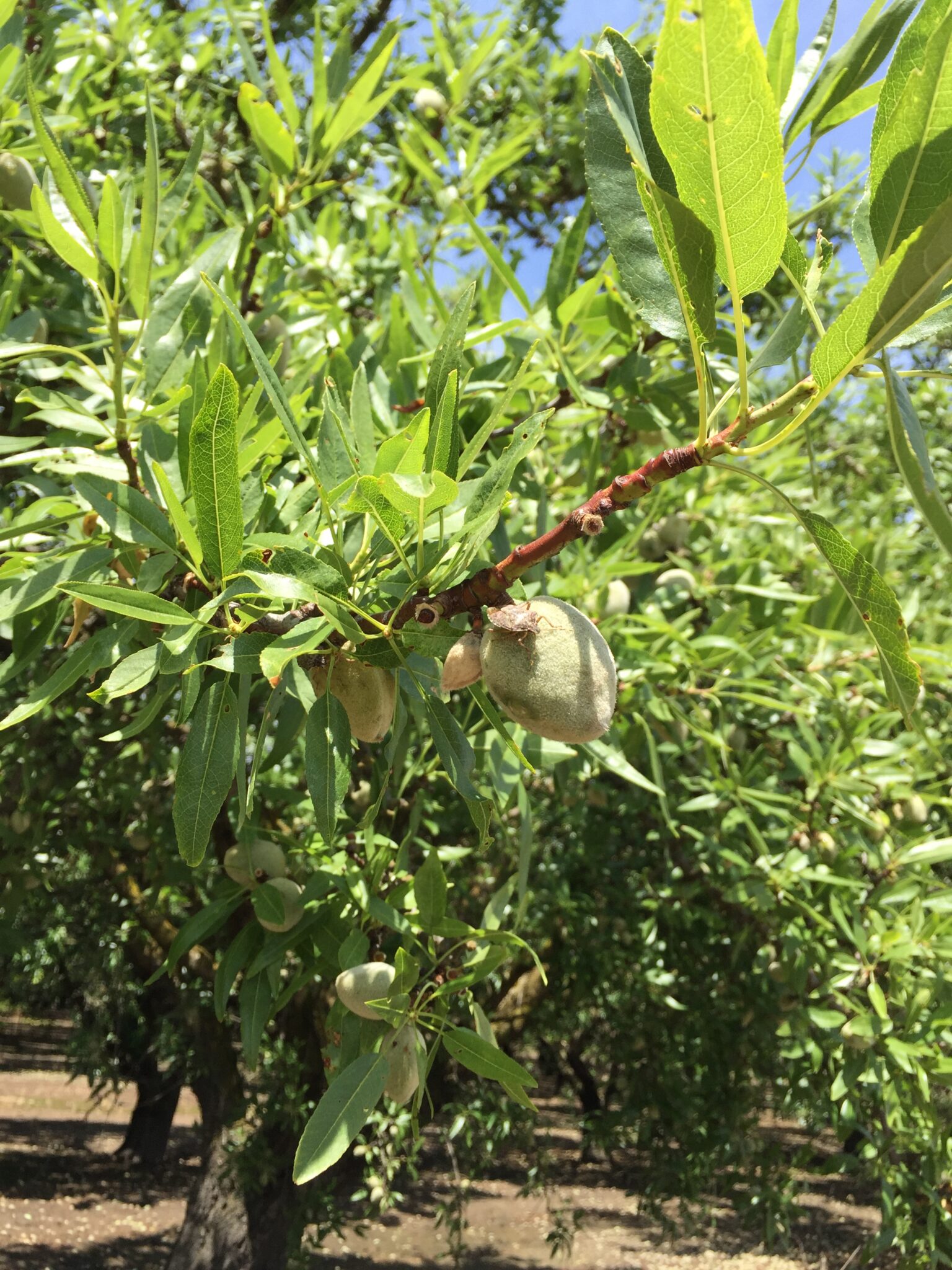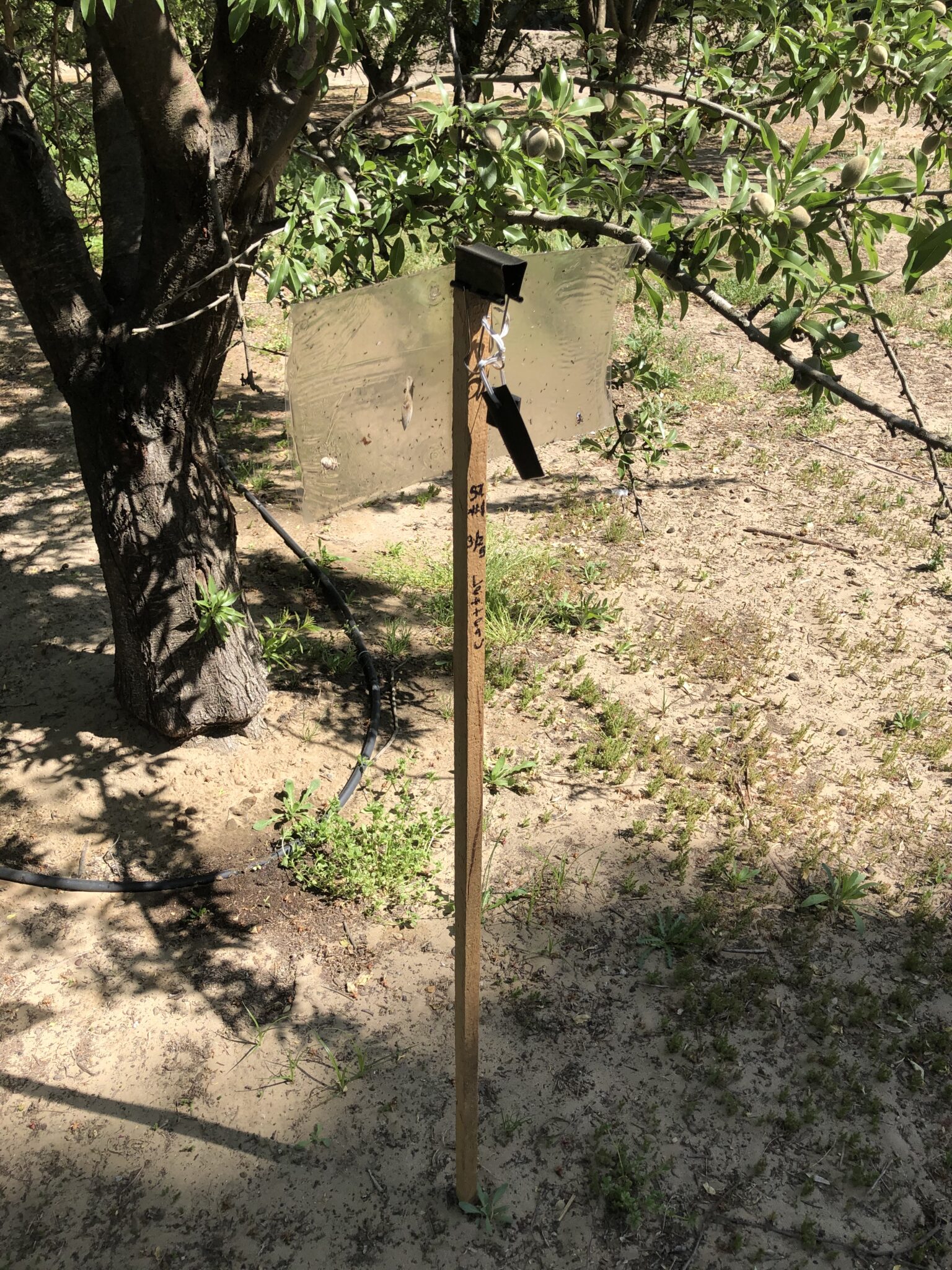
Five years after the brown marmorated stink bug (BMSB) first inflicted significant damage on a California crop, researchers still don’t know a lot about the bug’s threat to almonds. But after three-plus years of studying the pest, answers are beginning to emerge.
For one, researchers know that if present, the bug can damage almonds throughout a growing season. They know that early season damage can lead to significant nut drop. And they know the pest is particularly damaging to edge rows.
“We know that it is a border-driven pest,” said UCCE IPM Advisor for North San Joaquin Valley Jhalendra Rijal.
Rijal, like other researchers, was aware of the pest for many years before it struck peaches in the northern San Joaquin Valley in 2016. Almost immediately, he starting devising projects to try and understand the pest’s threat to almonds. In a UC Ag Experts Talk webinar in April, Rijal shared results of several BMSB-focused research projects he has conducted since then.
In one, designed to determine how long almonds are susceptible to the pest in a growing season, researchers released the stink bugs in exclusion cages in trees for 18 to 22 weeks, beginning at the fruit development stage. They found that early season damage was particularly significant, leading to dramatic nut drop inside the cages.
“In some cases, in the first two weeks, we saw close to 100% nut drop because of BMSB feeding,” Rijal said.
BMSB continued to damage the crop up to harvest, Rijal said. “Even in July and August, including just before harvest, you see these brown stains on kernels,” Rijal said. “That proved that if they are present, they will be able to cause economic damage throughout the season. Although the severity of damage could be less in the latter part of the season, they are capable of doing damage season-long.”
The researchers also tested differences in feeding damage between the BMSB and the leaffooted bug, which is slightly larger and has a longer stylet than the BMSB, where they looked at nut drop, hull injury and kernel damage.
They found the percent damage from leaffooted bug higher in the early part of the season. “But if you looked at the later part of the season, the first week of June on, you see that BMSB is causing a little higher damage than leaffooted bug,” Rijal said.
“Another thing to note,” he said, “is that these are control studies. In a natural environment, leaffooted bug presence in June and July is occasional, and, if they are present, they are small in number. That makes the leaffooted bug less risky than BMSB in the later part of the season.”
Edge Effect
In testing the edge effect, researchers placed traps at 40-foot gradients into an orchard and monitored catches weekly. They also compared nut damage at harvest between the different gradients.
“In the early part of the season, when the BMSB is moving into the orchard, you will see differences [between the edge traps and interior orchard traps],” Rijal said. “But when the population is [established] inside the orchard, there doesn’t seem to be much difference in terms of trap capture. But when we looked at the overall damage at harvest… we found substantially more damage on the edges.”
The research measured gummy kernels, kernels with dark spots and dimpled kernels in assessing damage.
In visual observations, the edge effect is even more pronounced, Rijal said. “When we took a picture of the first-row versus the third-row versus the fifth-row damage, even though we didn’t do quantification, the nut drop observed was less the further you go into an orchard.”
The edge effect, he noted, is largely driven by the fact that the pest overwinters in structures as well as trees and other host plants outside of an orchard and moves into an orchard as the growing season starts.
“As long as they have a source, other hosts nearby, the severity of this pest will be higher,” Rijal said.
The need for an overwintering host that helps shelter BMSB from cold temperatures, in fact, may be a limiting factor in the pest’s ability to inflict large-scale damage on almonds, Rijal said, particularly where the crop is produced in monoculture fashion. Also, he said, it is still unknown how the pest will react to the hot temperatures, especially in the southern part of the San Joaquin Valley during summer months, adding to the uncertainty surrounding this pest.
“In the Central Valley, the temperatures are pretty high, and there are dry conditions and also not many host plants compared to other states [where BMSB has flourished],” Rijal said. “Specially, in the monoculture system where there is nothing but almonds for miles, they might have a more difficult time establishing,” he said. “Still, I think it is causing a threat to the area where we are seeing its presence.”
Researchers also analyzed trapping methods, comparing results of a sticky trap with the more expensive pyramid trap. They found the sticky trap is perfectly adequate.
“Based on three years of trapping data, we are pretty confident the sticky panel trap can be used to monitor BMSB activity in the orchard,” Rijal said.

Pest Identification
In his webinar, Rijal also talked about the importance of differentiating between native stink bugs, leaffooted bugs and the invasive BMSB. All can be economically damaging to almonds, but even though BMSB can damage nuts throughout the growing season, issues with BMSB and leaffooted bugs typically are more pronounced in early season, whereas native stink bugs don’t tend to move into orchards until July or August.
Because of the late appearance of native stink bugs, the fruit is fully developed and bigger, and nut drop will not occur from native stink bug feeding, Rijal said. “That is different from leaffooted bugs. They tend to come into orchards in the early part of the season and cause nut drop.” Leaffooted bugs also can inflict damage into May and even June by feeding on fruit, causing kernel necrosis, which shows up as brown spots, but it is not as severe as the early season damage.
Among native stink bugs, the most commonly mistaken for the invasive BMSB are the rough stink bug and the Consperse stink bug. The rough stink bug can be differentiated from BMSB by its lack of white bands on the antennae, which are present on BMSB. The rough stink bug also has a more corrugated shoulder than the BMSB. The Consperse stink bug has numerous brown spots on its yellowish leg, which is not the case for the BMSB.
“Also,” Rijal said, “remember the presence of two white bands in BMSB.”
Rijal noted that at this point, UC researchers have not established treatment thresholds for stink bugs or leaffooted bugs. But, he said, if pest numbers are high, especially in the spring when nut sizes are small and not fully developed, growers should consider treating.
The top insecticide group for controlling leaffooted bugs, native stink bugs and the invasive BMSB is pyrethroid, he said.
One thing to consider, however, is these broad-spectrum materials are harmful to beneficial insects, he said.
Researchers currently are looking at the samurai wasp as a biological control option, Rijal added, but that option is a long way from being available for growers.
At this point, Rijal said, the BMSB is present and causing economic damage to commercial almond orchards in a limited geographic region. But the fact that it continues to expand its reach in newer commercial orchards, and the fact that when present it can cause significant damage, makes it a pest to keep an eye on.
Distribution of BMSB in California can be found at cisr.ucr.edu/invasive-species/brown-marmorated-stink-bug.










